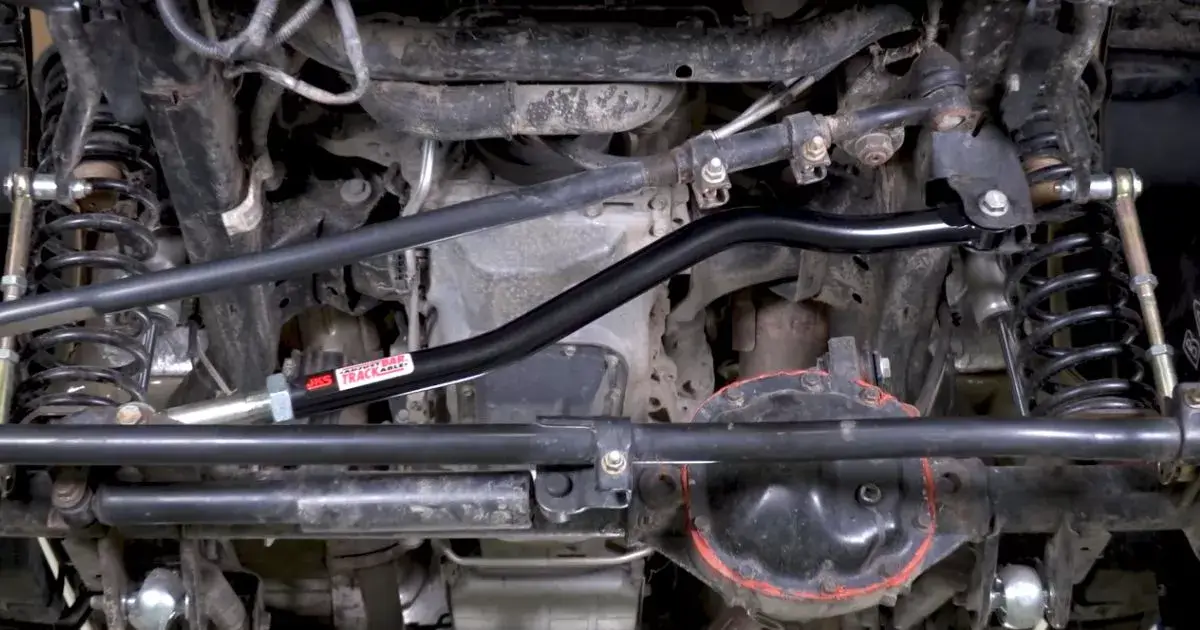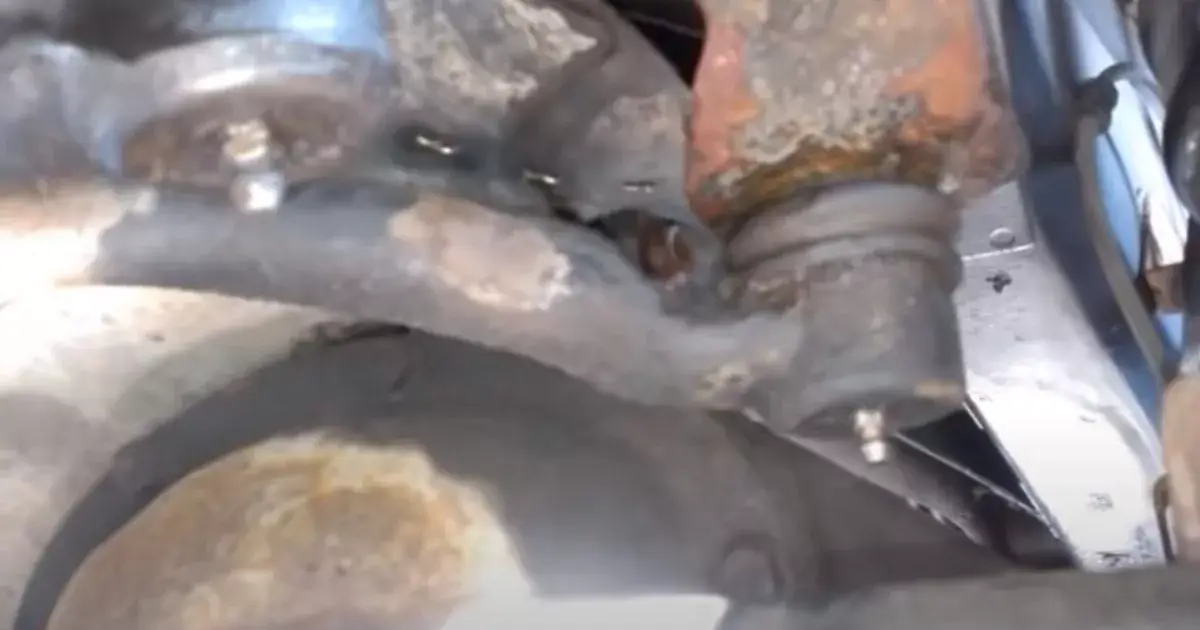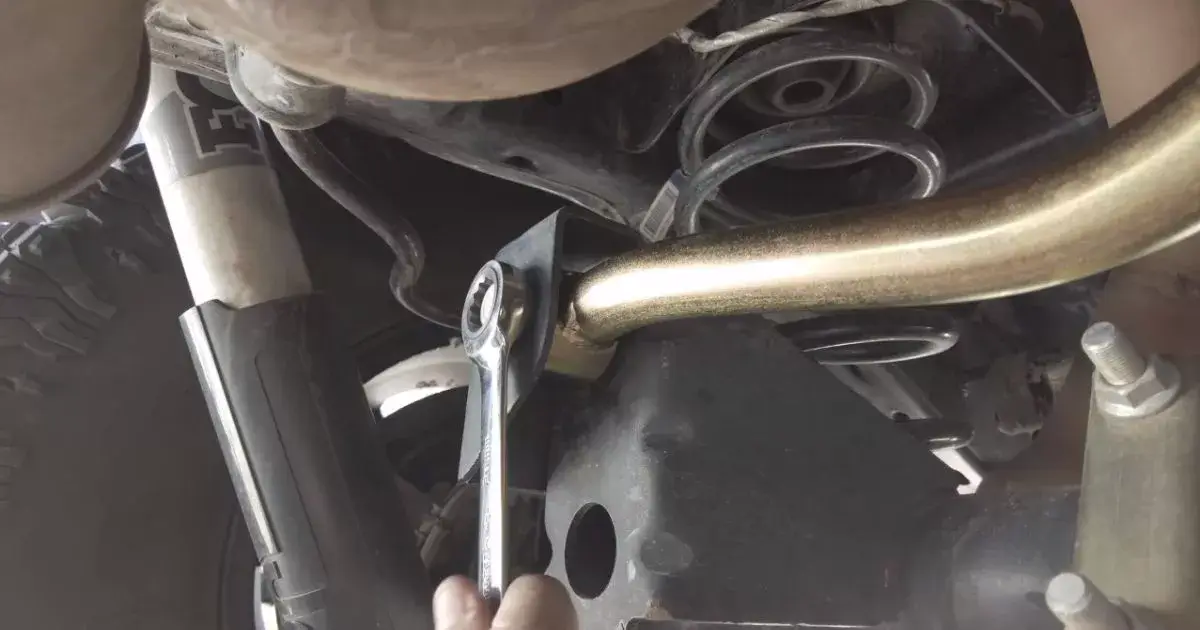A track bar is a suspension component found on many Jeep vehicles. It is also sometimes called a panhard bar or stabilizer bar. The track bar’s primary function is to keep the axle aligned with the frame of the vehicle.
It does this by attaching to the frame at one end and to the axle at the other. This keeps the axle from moving side to side, which can cause handling problems.
A track bar is a metal rod that connects the axle of your Jeep to the frame. It helps to keep the axles in alignment and prevents them from wobbling around. Many people think that the track bar is only important for off-roading, but it actually plays a vital role in on-road driving as well.
If your track bar is loose or damaged, it can cause your Jeep to shake or veer off course. That’s why it’s important to check your track bar regularly and replace it if necessary.

What Does a Track Bar Do
A track bar is a device that helps to keep your vehicle going in a straight line. It is mounted on the frame of your vehicle and connects to the axle. The track bar keeps the axle aligned with the frame, which helps to prevent your vehicle from veering off course.
If your track bar is not working properly, it can cause your vehicle to pull to one side or the other. This can be very dangerous, so it is important to make sure that your track bar is in good working order.
What Does a Front Track Bar Do
A front track bar is a suspension component that helps to keep the vehicle’s wheels in alignment. It is attached to the frame of the vehicle at one end, and to the steering knuckle at the other.
The track bar helps to prevent the wheels from ‘walking’ or ‘wandering’ while driving on uneven surfaces. It is an important safety feature and should be inspected regularly for wear and tear.

Jeep Track Bar Problems
If you own a Jeep, chances are you’ve had some track bar problems. And if you haven’t had track bar problems yet, just wait-you will eventually. It’s one of those things that comes with owning a Jeep.
But don’t worry, there are ways to fix it and prevent it from happening again. The first thing you need to do is figure out what is causing the problem. There are several possible causes:
Wear and Tear
The most common cause is simply wear and tear. Over time, your track bar will start to loosen up and become less effective. This is especially true if you take your Jeep off-road frequently. All that bouncing around takes its toll on the track bar and can eventually lead to problems.
Rust or Corrosion
Another possible cause is rust or corrosion. If your track bar is made of steel, it’s susceptible to rusting over time (especially if you live in an area with salt on the roads in winter). This can cause the track bar to seize up or break completely.
Track Bar Bushing Worn Out or Broken
Another possibility is that your track bar bushing has worn out or broken. This is a rubber bushing that sits between the frame and the track bar itself, and it helps keep everything aligned properly. Over time, these bushings can dry out and crack, which can lead to alignment issues (and ultimately, track bar problems).
What Causes Track Bar Failure?
The track bar is an important component of a vehicle’s suspension, and it can fail for a number of reasons.
- One common cause of track bar failure is corrosion. Over time, the track bar can become corroded due to exposure to moisture and road salt. This can cause the track bar to break or bend, which can lead to steering problems.
- Another common cause of track bar failure is impact damage. If the track bar hits something hard enough, it can break or bend. This can also lead to steering problems.
- Finally, wear and tear can also cause the track bar to fail over time. The bushings that connect the track bar to the frame can wear out, causing the track bar to loosen and eventually fail.
How Do I Know If My Jeep Track Bar is Bad?
If your Jeep is showing any of the following symptoms, it’s a good indication that your track bar is bad and needs to be replaced:
Uneven Tire Wear
If you notice that one of your tires is wearing down more quickly than the others, it’s likely due to your track bar being out of alignment. This will cause your Jeep to pull to one side when driving.
Unstable or “wobbly” in High-Speed Driving
Your Jeep feels unstable or “wobbly” when driving at high speeds – this is another symptom of a misaligned track bar. It can be dangerous to drive like this, so it’s important to get it fixed as soon as possible.
Noise from Suspension
3. You hear strange noises coming from the suspension area – if you’re hearing creaking, popping, or grinding noises coming from under your Jeep, it’s a good chance that the track bar is the culprit. These sounds are caused by the components rubbing against each other and should be addressed promptly.

Jeep Track Bar Adjustment
If your Jeep is like most, it has a track bar that helps to keep the axle aligned under the vehicle. Over time, however, this component can become loose, causing the Jeep to wander off course. Luckily, adjusting a track bar is a relatively easy process that anyone can do with a few simple tools.
- First, you’ll need to locate the track bar on your Jeep. It should be mounted somewhere near the center of the axle, and will likely have two nuts or bolts holding it in place. Once you’ve found it, loosen these so that you can move the track bar around.
- Next, take a look at how the track bar is mounted. There are typically two ways that it can be adjusted: by moving the entire assembly on its mount, or by rotating one end of the track bar itself. If yours is adjustable via rotation, simply rotate it until the desired alignment is achieved.
If yours needs to be moved on its mount, slide it over until it’s where you want it before tightening down those nuts or bolts again.
That’s all there is adjusting a track bar! By taking care of this simple maintenance item regularly, you can help keep your Jeep running straight and true for many miles to come.
Does the Track Bar Affect Steering?
The track bar also called the Panhard rod or lateral locating arm is a suspension component that helps keep the axle of a vehicle aligned with the frame.
The track bar is attached to the frame at one end and to the axle at the other. As the suspension moves up and down, the track bar keeps the axle centered side-to-side so that it doesn’t wander off course.
This is especially important when going around turns. While most vehicles have a track bar, some don’t need one because their design keeps the axle properly positioned without one.
For example, many four-wheel-drive trucks have what’s called an “independent front suspension. This type of suspension uses upper and lower control arms (instead of a track bar) to keep each wheel positioned correctly as it moves up and down.
How Do You Know If Your Track Bar is Bad?
The track bar is an important suspension component in your vehicle. It helps to keep the wheels in alignment and prevents the vehicle from veering off course. If the track bar is not functioning properly, it can cause a number of problems with your vehicle’s handling.
Here are some signs that your track bar might be bad:
Vehicle pulls to one side in driving
The vehicle pulls to one side while driving If you notice that your vehicle starts to pull to one side while you’re driving, it could be a sign that the track bar is not working properly.
This problem can be caused by a number of things, but if the track bar is bad, it will likely need to be replaced.
Wandering Steering
The steering feels loose or “wandering” Another common symptom of a bad track bar is loose or “wandering” steering. If you feel like you have to constantly correct your steering when driving straight ahead, it’s a good indication that something is wrong with the track bar.
This problem can also be caused by other suspension components, so it’s important to have it checked out by a mechanic as soon as possible.
Sways excessively while turning
The vehicle sways excessively while turning or going over bumps. If you notice that your car starts to sway excessively while making turns or going over bumps in the road, it’s likely due to a problem with the track bar.
This issue can make driving extremely difficult and dangerous, so again, it’s important to get it checked out right away.
Track Bar Vs Sway Bar
There are two main types of suspension bars that help to stabilize a vehicle while driving: track bars and sway bars. Both work to keep the vehicle level and prevent it from rolling over, but they do so in different ways.
Track Bar
A track bar is a straight, solid piece of metal that runs from one side of the axle to the other. It helps to keep the axle aligned and prevents it from moving side-to-side.
Swary Bar
A sway bar, on the other hand, is a curved piece of metal that connects the left and right sides of the suspension. It works by transferring force from one side to the other, which helps to keep the car stable in turns.
So, which one is better? That depends on your driving needs.
If you do a lot of off-roading or live in an area with lots of windy roads, then a track bar is probably a better choice for you. If you mostly stick to highways and city streets, then a sway bar will likely be sufficient.
Why do I need a longer Track Bar?
Wrapping UP
The track bar is an important suspension component on a Jeep that helps to keep the vehicle stable while driving. It is connected to the frame of the Jeep at one end, and to the axle at the other. The track bar helps to keep the axle aligned with the frame and prevents it from moving side-to-side.
This is especially important when driving off-road, as uneven terrain can cause the axle to shift and potentially lead to a rollover.

